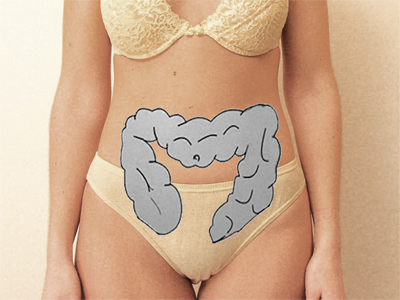The large intestine (colon) takes in a great deal of space in the abdominal cavity
[Figure 43]. Nevertheless, it is usually impalpable. Even under pathologic conditions the transverse colon can easily slide unnoticed beneath the palpating hand because, in contrast to the rest of the colon, it is suspended in the mesenterium (transverse mesocolon) and is therefore able to move freely within the abdomen. Colon abnormalities, if symptomatic, almost always lead to changes in bowel movements. However, colon tumours can be present without noticeable abdominal symptoms. If malignancy is suspected based on general symptoms, abdominal examination is indicated.
 Figure 43
Figure 43
Inspection
Determine the colour of the skin and mucous membranes (anaemia).
Percussion
Normally, the colon does not yield any findings on percussion. A swollen or air-filled colon produces tympany. Pain on percussion in the lower left abdomen may be an indication of diverticulitis.
Palpation
Procedure
- Have the patient breathe normally.
- Use the technique described for deep palpation (bimanual).
- Palpate calmly, carefully and gradually deeper.
Careless palpation can cause pain and active muscle guarding. - During each palpation, move the palpating fingers back and forth perpendicular to the course of the colon. Begin by palpating the lower right abdomen, lateral to the right rectus abdominis muscle. Follow the ascending colon, moving by hand-width increments, and stop at the level of the hepatic flexure. From the site of the splenic flexure, continue palpating the descending colon and the sigmoid colon as far as possible into the lesser pelvis [Figure 44].
- Examination of the large intestine is not complete without a rectal examination (see: Examination of the anus and rectal examination).
 Figure 44
Figure 44
Focus points
- Check for sites of palpable masses along the course of the colon.
The large intestine may be more accessible for palpation in slender patients with a thin or weak abdominal wall.
The colon is usually impalpable, but if the intestine is strongly contracted (spastic colon), the sigmoid colon may be palpable in the lower left abdomen: it will feel like a cord and may be rolled between palpating fingers (this usually induces an unpleasant sensation in patients).
If a sausage-shaped cord of varying consistency can be felt at other locations, it may be the colon containing compacted faeces.
If a smooth-surfaced mass is palpable that has the compliance of an inflated balloon, it may mean that the intestinal wall of the colon is under high tension due to air pressure (gaseous distension of the intestine). (Tympany will be heard on percussion of this region.)
- For a palpable mass, determine:
- the trajectory along which it is palpable (in centimetres);
- the diameter (in centimetres);
- the consistency (usually firm, but can be very firm under pathologic conditions);
- the quality of the surface (normally smooth, but can be irregular and bumpy under pathologic conditions);
- palpation tenderness (under normal conditions, the colon is not painful upon palpation).




























